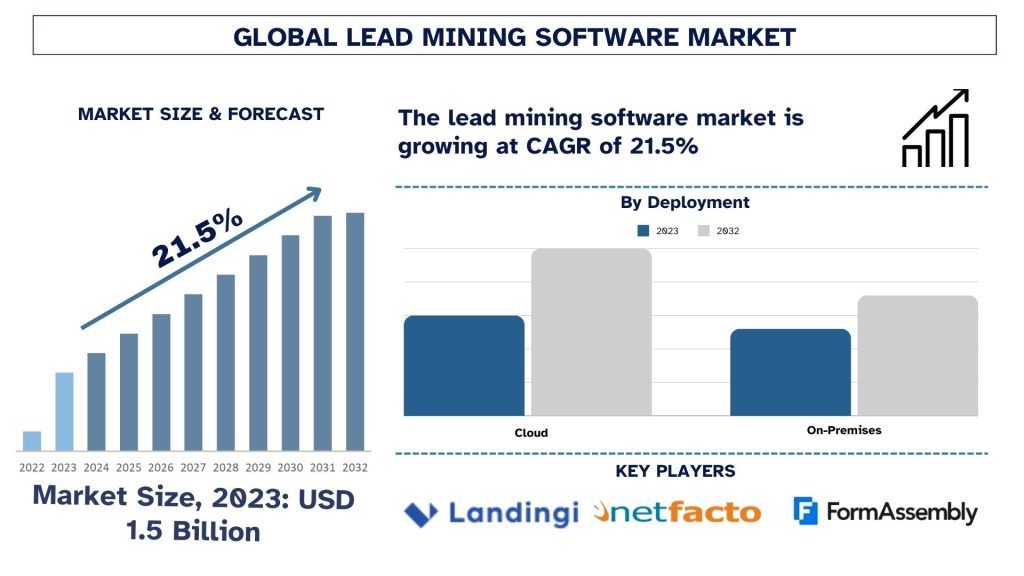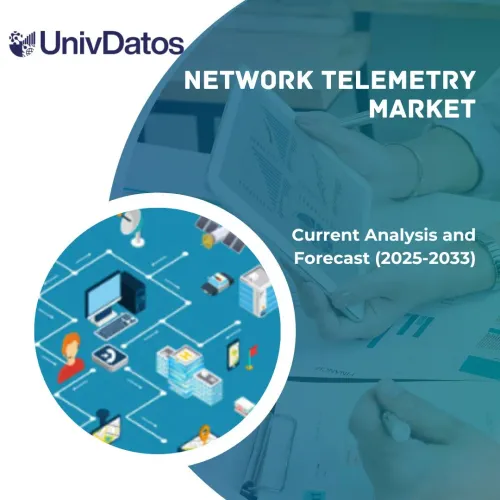- Trang chủ
- Về chúng tôi
- Ngành
- Dịch vụ
- Đọc
- Liên hệ với chúng tôi
Thị trường Phần mềm Khai thác Khách hàng tiềm năng: Phân tích Hiện tại và Dự báo (2024-2032)
Nhấn mạnh vào Triển khai (Tại chỗ và Đám mây); Ứng dụng (Doanh nghiệp vừa và nhỏ và Doanh nghiệp lớn); và Khu vực/Quốc gia
Quy mô và dự báo thị trường phần mềm khai thác khách hàng tiềm năng
Thị trường phần mềm khai thác khách hàng tiềm năng được định giá khoảng 1,5 tỷ USD vào năm 2023 và dự kiến sẽ tăng trưởng với tốc độ CAGR mạnh mẽ khoảng 21,5% trong giai đoạn dự báo (2024-2032). Sự tăng trưởng của thị trường phần mềm khai thác khách hàng tiềm năng toàn cầu được thúc đẩy bởi nhu cầu ngày càng tăng đối với các chiến lược tiếp thị dựa trên dữ liệu, tự động hóa và tương tác khách hàng được cá nhân hóa.
Phân tích thị trường phần mềm khai thác khách hàng tiềm năng
Các doanh nghiệp sử dụng phần mềm khai thác khách hàng tiềm năng để tìm kiếm các cơ hội kinh doanh mới từ cơ sở dữ liệu khách hàng, thông tin lịch sử bán hàng, khách truy cập trang web, người theo dõi trên mạng xã hội và hơn thế nữa. Khai thác khách hàng tiềm năng giúp các nhóm bán hàng phát triển quy trình giao dịch của họ bằng cách tìm kiếm khách hàng tiềm năng mới từ dữ liệu hiện có và các cơ hội bán thêm mới cho khách hàng hiện tại. Thông qua quy trình khai thác, người bán và nhà tiếp thị cũng có thể xác minh thông tin khách hàng hiện có (chẳng hạn như thông tin liên hệ) hoặc thêm thông tin mới về khách hàng hiện có để cải thiện chất lượng dữ liệu khách hàng.
Sự gia tăng trong việc áp dụng phần mềm khai thác khách hàng tiềm năng chủ yếu là do sự gia tăng số lượng người dùng email và sự gia tăng số lượng người dùng Internet, làm tăng số lượng khách truy cập trang web. Hơn nữa, số lượng người dùng mạng xã hội ngày càng tăng dự kiến sẽ có tác động đáng kể đến sự tăng trưởng của thị trường. Ví dụ: vào năm 2020, số lượng người dùng mạng xã hội toàn cầu đạt 4,74 tỷ người, chiếm khoảng 59,3% dân số toàn cầu.
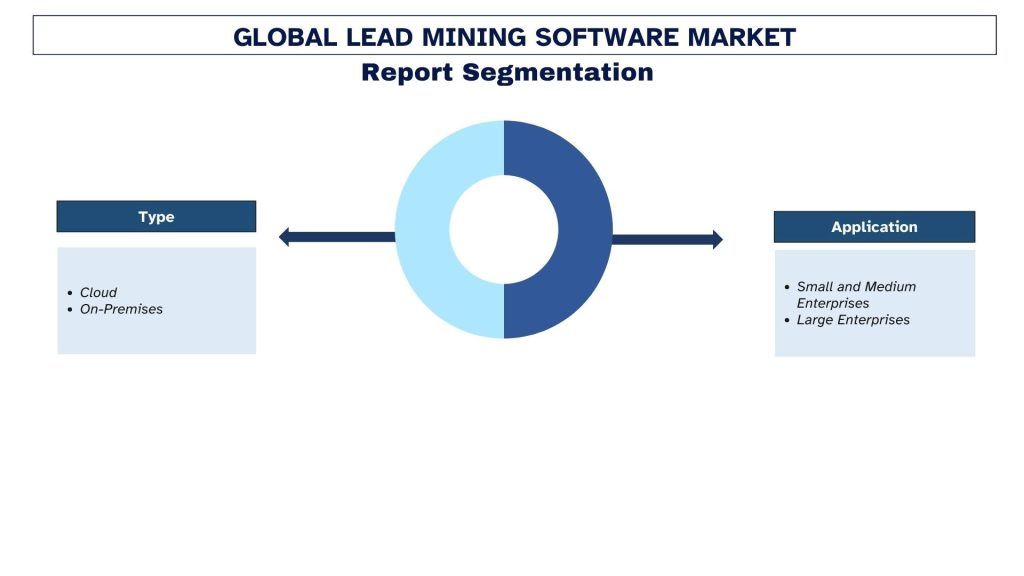
Xu hướng thị trường phần mềm khai thác khách hàng tiềm năng
Phần này thảo luận về các xu hướng thị trường chính ảnh hưởng đến các phân khúc Phần mềm Khai thác Khách hàng tiềm năng theo xác định của các chuyên gia nghiên cứu của chúng tôi.
Phân khúc đám mây chuyển đổi ngành công nghiệp
Dựa trên hình thức triển khai, thị trường được chia thành đám mây và tại chỗ. Phân khúc đám mây dự kiến sẽ tăng trưởng với tốc độ CAGR đáng kể trong giai đoạn dự báo. Quản lý khách hàng tiềm năng rất tốn dữ liệu, điều này sẽ khiến việc triển khai trên bất kỳ cơ sở hạ tầng nào khác trở nên rất tốn kém. Hơn nữa, các ứng dụng được triển khai trên đám mây có thể truy cập từ mọi nơi, điều này khiến nó trở thành một lựa chọn triển khai lý tưởng cho các tổ chức.
Bắc Mỹ sẽ nắm giữ một thị phần đáng kể trên thị trường
Vào năm 2023, Bắc Mỹ nắm giữ một thị phần đáng kể trên thị trường phần mềm khai thác khách hàng tiềm năng toàn cầu. Sự tăng trưởng trong khu vực chủ yếu là do sự hiện diện của các công ty chủ chốt trong khu vực như Lusha Systems Ltd, Clearbit, NetLine Corporation và LeadIQ Inc cùng những công ty khác. Hơn nữa, khu vực này có các nền kinh tế phát triển như Hoa Kỳ và Canada đầu tư mạnh vào nghiên cứu và phát triển phần mềm khai thác khách hàng tiềm năng. Hơn nữa, chính phủ của khu vực cũng thúc đẩy các doanh nghiệp vừa và nhỏ, điều này dự kiến sẽ thúc đẩy thị trường trong khu vực.
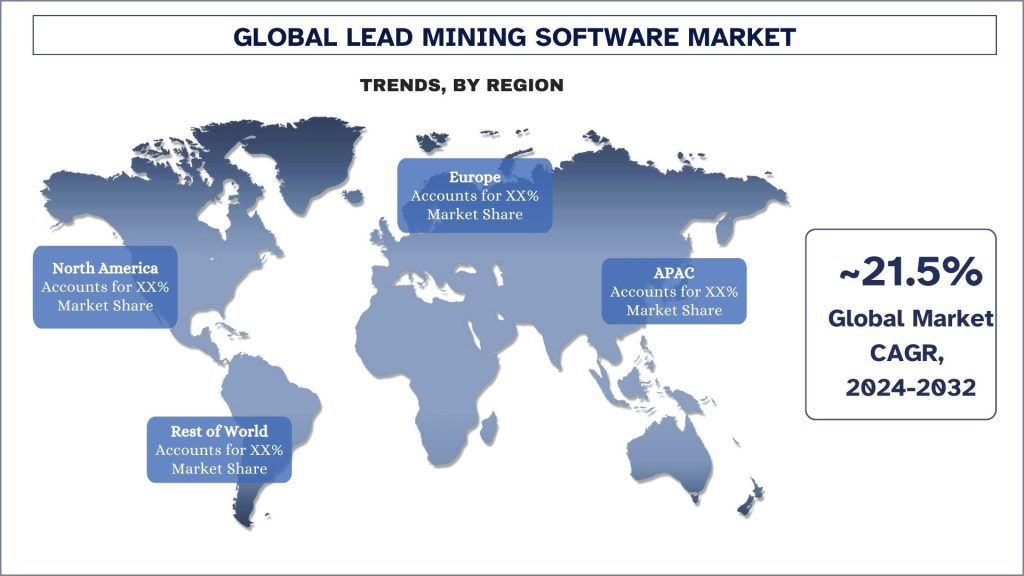
Tổng quan về ngành phần mềm khai thác khách hàng tiềm năng
Thị trường Phần mềm Khai thác Khách hàng tiềm năng có tính cạnh tranh, với một số người chơi thị trường toàn cầu và quốc tế. Các công ty chủ chốt đang áp dụng các chiến lược tăng trưởng khác nhau để tăng cường sự hiện diện trên thị trường của họ, chẳng hạn như hợp tác, thỏa thuận, cộng tác, ra mắt sản phẩm mới, mở rộng địa lý và sáp nhập và mua lại. Một số công ty lớn hoạt động trên thị trường là Landingi, netFactor, CallRail Inc., Form Assembly Inc, Lusha Systems Inc, Clearbit, NetLine Corporation, LeadIQ Inc, Datanyze, HubSpot, Inc. Một số vụ M&A cùng với quan hệ đối tác đã được thực hiện bởi những người chơi này để tạo điều kiện cho khách hàng với các sản phẩm/công nghệ công nghệ cao và tiên tiến.
Phạm vi báo cáo thị trường phần mềm khai thác khách hàng tiềm năng
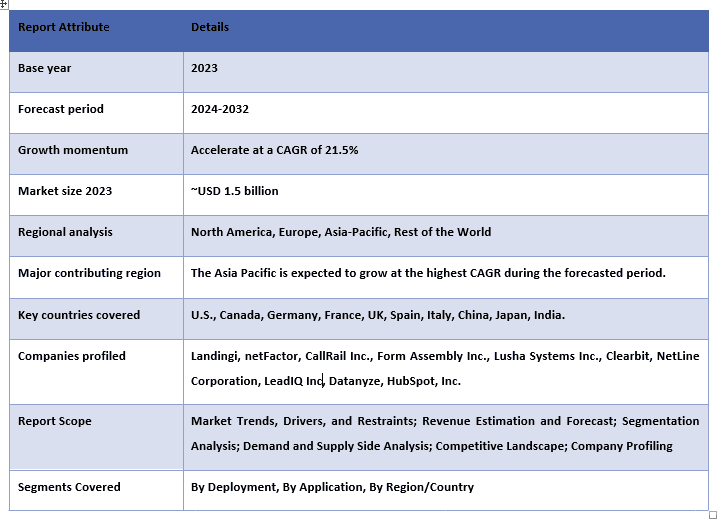
Lý do nên mua báo cáo này:
- Nghiên cứu bao gồm phân tích kích thước và dự báo thị trường được xác thực bởi các chuyên gia ngành công nghiệp chủ chốt đã được xác thực.
- Báo cáo trình bày đánh giá nhanh về hiệu quả hoạt động chung của ngành trong nháy mắt.
- Báo cáo bao gồm phân tích chuyên sâu về các đồng nghiệp trong ngành nổi bật với trọng tâm chính vào tài chính kinh doanh, danh mục sản phẩm, chiến lược mở rộng và các phát triển gần đây.
- Kiểm tra chi tiết các động lực, hạn chế, xu hướng chính và cơ hội hiện hành trong ngành.
- Nghiên cứu bao gồm toàn diện thị trường trên các phân khúc khác nhau.
- Phân tích chuyên sâu về ngành ở cấp độ khu vực.
Tùy chọn tùy chỉnh:
Phần mềm khai thác khách hàng tiềm năng toàn cầu có thể được tùy chỉnh thêm theo yêu cầu hoặc bất kỳ phân khúc thị trường nào khác. Bên cạnh đó, UMI hiểu rằng bạn có thể có nhu cầu kinh doanh riêng; do đó, vui lòng kết nối với chúng tôi để nhận được một báo cáo hoàn toàn phù hợp với yêu cầu của bạn.
Mục lục
Phương Pháp Nghiên Cứu Phân Tích Thị Trường Phần Mềm Khai Thác Khách Hàng Tiềm Năng (2022-2032)
Phân tích thị trường lịch sử, ước tính thị trường hiện tại và dự báo thị trường tương lai của thị trường Phần mềm Khai thác Khách hàng Tiềm năng toàn cầu là ba bước chính được thực hiện để tạo và phân tích việc áp dụng Phần mềm Khai thác Khách hàng Tiềm năng ở các khu vực lớn trên toàn cầu. Nghiên cứu thứ cấp chuyên sâu đã được thực hiện để thu thập các số liệu thị trường lịch sử và ước tính quy mô thị trường hiện tại. Thứ hai, nhiều phát hiện và giả định đã được xem xét để xác nhận những thông tin chi tiết này. Hơn nữa, các cuộc phỏng vấn sơ cấp chuyên sâu cũng đã được thực hiện với các chuyên gia trong ngành trên toàn bộ chuỗi giá trị của thị trường Phần mềm Khai thác Khách hàng Tiềm năng toàn cầu. Sau khi giả định và xác nhận số liệu thị trường thông qua các cuộc phỏng vấn sơ cấp, chúng tôi đã sử dụng phương pháp tiếp cận từ trên xuống/từ dưới lên để dự báo quy mô thị trường hoàn chỉnh. Sau đó, các phương pháp phân tích chi tiết thị trường và đoạc tam giác dữ liệu đã được áp dụng để ước tính và phân tích quy mô thị trường của các phân khúc và phân nhóm của ngành. Phương pháp chi tiết được giải thích dưới đây:
Phân Tích Quy Mô Thị Trường Lịch Sử
Bước 1: Nghiên Cứu Chuyên Sâu Các Nguồn Thứ Cấp:
Một nghiên cứu thứ cấp chi tiết đã được thực hiện để thu thập quy mô thị trường lịch sử của thị trường Phần mềm Khai thác Khách hàng Tiềm năng thông qua các nguồn nội bộ của công ty như báo cáo thường niên & báo cáo tài chính, các bài thuyết trình về hiệu suất, thông cáo báo chí, v.v. và các nguồn bên ngoài bao gồm tạp chí, tin tức & bài viết, ấn phẩm của chính phủ, ấn phẩm của đối thủ cạnh tranh, báo cáo ngành, cơ sở dữ liệu của bên thứ ba và các ấn phẩm đáng tin cậy khác.
Bước 2: Phân Khúc Thị Trường:
Sau khi thu thập quy mô thị trường lịch sử của Phần mềm Khai thác Khách hàng Tiềm năng, chúng tôi đã tiến hành phân tích thứ cấp chi tiết để thu thập thông tin chi tiết và chia sẻ thị trường lịch sử cho các phân khúc & phân nhóm khác nhau cho các khu vực lớn. Các phân khúc chính được bao gồm trong báo cáo, chẳng hạn như triển khai, ứng dụng và khu vực. Các phân tích cấp quốc gia sâu hơn đã được thực hiện để đánh giá việc áp dụng chung các mô hình kiểm tra ở khu vực đó.
Bước 3: Phân Tích Yếu Tố:
Sau khi thu thập quy mô thị trường lịch sử của các phân khúc và phân nhóm khác nhau, chúng tôi đã tiến hành phân tích yếu tố chi tiết để ước tính quy mô thị trường hiện tại của thị trường Phần mềm Khai thác Khách hàng Tiềm năng. Hơn nữa, chúng tôi đã tiến hành phân tích yếu tố bằng cách sử dụng các biến phụ thuộc và độc lập như triển khai, ứng dụng và các khu vực Phần mềm Khai thác Khách hàng Tiềm năng. Một phân tích kỹ lưỡng đã được thực hiện về các kịch bản phía cung và cầu, xem xét các quan hệ đối tác hàng đầu, sáp nhập và mua lại, mở rộng kinh doanh và ra mắt sản phẩm trong lĩnh vực thị trường Phần mềm Khai thác Khách hàng Tiềm năng trên toàn cầu.
Ước Tính & Dự Báo Quy Mô Thị Trường Hiện Tại
Định cỡ Thị trường Hiện tại: Dựa trên những thông tin chi tiết hữu ích từ ba bước trên, chúng tôi đã xác định quy mô thị trường hiện tại, những người chơi chính trong thị trường Phần mềm Khai thác Khách hàng Tiềm năng toàn cầu và thị phần của các phân khúc. Tất cả các tỷ lệ phần trăm cần thiết và phân tích chi tiết thị trường đã được xác định bằng cách sử dụng phương pháp thứ cấp đã đề cập ở trên và đã được xác minh thông qua các cuộc phỏng vấn sơ cấp.
Ước tính & Dự báo: Để ước tính và dự báo thị trường, trọng số đã được gán cho các yếu tố khác nhau bao gồm các động lực & xu hướng, hạn chế và cơ hội có sẵn cho các bên liên quan. Sau khi phân tích các yếu tố này, các kỹ thuật dự báo có liên quan, tức là phương pháp tiếp cận từ trên xuống/từ dưới lên đã được áp dụng để đưa ra dự báo thị trường cho năm 2032 cho các phân khúc và phân nhóm khác nhau trên các thị trường lớn trên toàn cầu. Phương pháp nghiên cứu được áp dụng để ước tính quy mô thị trường bao gồm:
Quy mô thị trường của ngành, về doanh thu (USD) và tỷ lệ chấp nhận Phần mềm Khai thác Khách hàng Tiềm năng trên các thị trường lớn trong nước
Tất cả các tỷ lệ phần trăm, phân chia và phân tích chi tiết các phân khúc và phân nhóm thị trường
Những người chơi chính trong Phần mềm Khai thác Khách hàng Tiềm năng toàn cầu về các sản phẩm được cung cấp. Ngoài ra, các chiến lược tăng trưởng được những người chơi này áp dụng để cạnh tranh trong thị trường đang phát triển nhanh chóng
Xác Nhận Quy Mô và Thị Phần Thị Trường
Nghiên cứu Sơ cấp: Các cuộc phỏng vấn chuyên sâu đã được thực hiện với các Nhà Lãnh Đạo Tư Tưởng Chủ Chốt (KOL), bao gồm các Giám đốc Điều hành Cấp Cao (CXO/Phó Chủ tịch, Trưởng phòng Kinh doanh, Trưởng phòng Tiếp thị, Trưởng phòng Vận hành, Trưởng khu vực, Trưởng quốc gia, v.v.) trên khắp các khu vực lớn. Các phát hiện nghiên cứu sơ cấp sau đó đã được tóm tắt và phân tích thống kê đã được thực hiện để chứng minh giả thuyết đã nêu. Thông tin đầu vào từ nghiên cứu sơ cấp đã được hợp nhất với các phát hiện thứ cấp, do đó biến thông tin thành những thông tin chi tiết hữu ích.
Phân Chia Người Tham Gia Sơ Cấp ở Các Khu Vực Khác Nhau
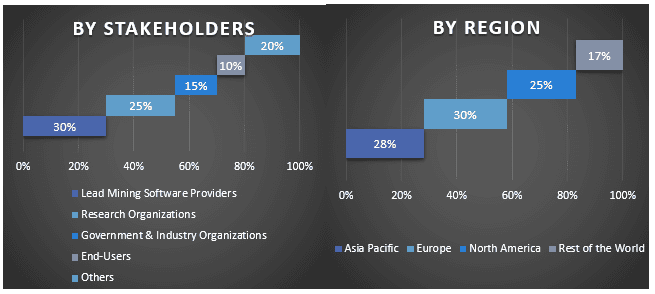
Kỹ Thuật Thị Trường
Kỹ thuật đoạc tam giác dữ liệu đã được sử dụng để hoàn thành việc ước tính thị trường tổng thể và để đưa ra các số liệu thống kê chính xác cho từng phân khúc và phân nhóm của Phần mềm Khai thác Khách hàng Tiềm năng toàn cầu. Dữ liệu đã được chia thành một số phân khúc và phân nhóm sau khi nghiên cứu các thông số và xu hướng khác nhau trong việc triển khai, ứng dụng và khu vực của thị trường Phần mềm Khai thác Khách hàng Tiềm năng toàn cầu.
Mục tiêu chính của Nghiên cứu Thị trường Phần mềm Khai thác Khách hàng Tiềm năng Toàn cầu
Các xu hướng thị trường hiện tại & tương lai của Phần mềm Khai thác Khách hàng Tiềm năng toàn cầu đã được xác định chính xác trong nghiên cứu. Các nhà đầu tư có thể thu được những thông tin chi tiết chiến lược để dựa vào quyết định đầu tư của họ dựa trên phân tích định tính và định lượng được thực hiện trong nghiên cứu. Các xu hướng thị trường hiện tại và tương lai xác định sức hấp dẫn tổng thể của thị trường ở cấp khu vực, cung cấp một nền tảng cho người tham gia công nghiệp khai thác thị trường chưa được khai thác để hưởng lợi từ lợi thế của người đi đầu. Các mục tiêu định lượng khác của các nghiên cứu bao gồm:
- Phân tích quy mô thị trường hiện tại và dự báo của thị trường Phần mềm Khai thác Khách hàng Tiềm năng về giá trị (USD). Ngoài ra, phân tích quy mô thị trường hiện tại và dự báo của các phân khúc và phân nhóm khác nhau.
- Các phân khúc trong nghiên cứu bao gồm các lĩnh vực triển khai, ứng dụng và khu vực.
- Xác định và phân tích khuôn khổ pháp lý cho Phần mềm Khai thác Khách hàng Tiềm năng
- Phân tích chuỗi giá trị liên quan đến sự hiện diện của nhiều trung gian khác nhau, cùng với việc phân tích hành vi của khách hàng và đối thủ cạnh tranh trong ngành.
- Phân tích quy mô thị trường hiện tại và dự báo của thị trường Phần mềm Khai thác Khách hàng Tiềm năng cho các khu vực lớn.
- Các quốc gia lớn của các khu vực được nghiên cứu trong báo cáo bao gồm Châu Á Thái Bình Dương, Châu Âu, Bắc Mỹ và Phần còn lại của Thế giới
- Hồ sơ công ty của thị trường Phần mềm Khai thác Khách hàng Tiềm năng và các chiến lược tăng trưởng được những người chơi trên thị trường áp dụng để duy trì trong thị trường đang phát triển nhanh chóng.
- Phân tích sâu về ngành ở cấp khu vực
Câu hỏi thường gặp Câu hỏi thường gặp
Hỏi 1: Quy mô hiện tại và tiềm năng tăng trưởng của Phần mềm Khai thác Chì toàn cầu là gì?
Câu hỏi 2: Động lực thúc đẩy sự tăng trưởng của Phần mềm Khai thác Chì toàn cầu là gì?
Q3: Phân khúc nào chiếm thị phần lớn nhất của phần mềm khai thác chì toàn cầu theo phương thức triển khai?
Q4: Các công nghệ và xu hướng mới nổi trong phần mềm khai thác khách hàng tiềm năng toàn cầu là gì?
Q5: Khu vực nào sẽ thống trị phần mềm khai thác chì toàn cầu?
Liên quan Báo cáo
Khách hàng đã mua mặt hàng này cũng đã mua

